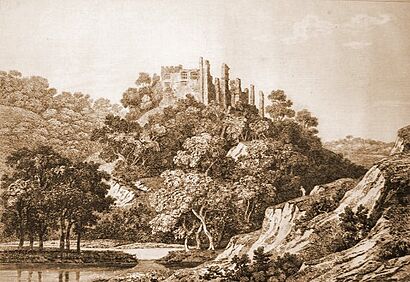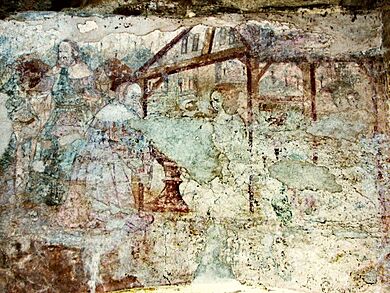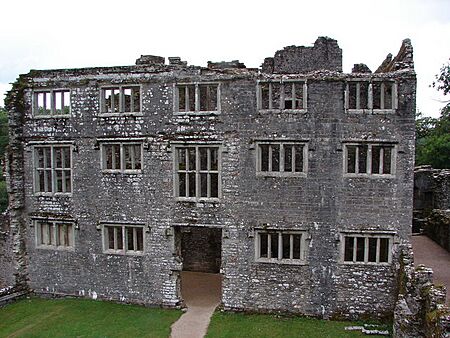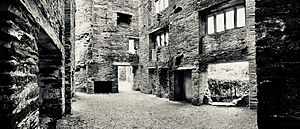Berry Pomeroy Castle facts for kids
Quick facts for kids Berry Pomeroy Castle |
|
|---|---|
 |
|
| General information | |
| Type | Castle |
| Location | Berry Pomeroy, England |
| Coordinates | 50°26′56″N 3°38′12″W / 50.4490°N 3.6366°W |
| Demolished | After 1694 |
| Owner | The 19th Duke of Somerset (with administration by English Heritage) |
Berry Pomeroy Castle is a fascinating old castle near the village of Berry Pomeroy in South Devon, England. It's actually a Tudor mansion built inside the walls of an even older castle!
The Pomeroy family, who owned the land since the 11th century, built the first castle in the late 1400s. By 1547, they faced money problems and sold the land to Edward Seymour, 1st Duke of Somerset. The castle has mostly stayed with the Seymour family ever since. However, it was left empty in the late 1600s when the fourth baronet moved away.
For about a hundred years, the castle was a ruin. But in the 1800s, people started to see its beauty as a "picturesque" ruin. It became a popular place for tourists, and it still is today! Many people also believe it's haunted, which adds to its mystery. Between 1980 and 1996, archaeologists carefully dug up parts of the castle. Their work helped us understand its true history and how old it really is.
Contents
Where is Berry Pomeroy Castle?
Berry Pomeroy Castle is located about 1 mile (1.6 km) north-east of the village of Berry Pomeroy in South Devon. It sits on a limestone hill that looks over a deep, wooded valley. This valley is carved out by a stream called Gatcombe Brook.
The Castle's Long History
The Pomeroy Family's Castle
The de la Pomeroy family received the land of Berry Pomeroy shortly after the Norman Conquest in 1066. Records from 1086, like the Domesday Book, show they owned a large area. Early papers mention a main house at Berry, which was the most important building of their land.
Even though Henry Pomeroy created a deer park here in 1207, the first time a "castle" is mentioned is in 1496. This document suggests the castle and the main house were in different places. Experts now think the main house was near Berry House in the nearby village.
Archaeological findings, especially the design of the gun ports in the gatehouse and St. Margaret's Tower, tell us the castle was likely built in the late 1400s. These parts, along with the outer curtain wall, are the oldest sections. It was one of the last traditional castles built in England for a family to live in. It was placed in a favorite spot within the Pomeroy's deer park.
The Pomeroy castle had a dry moat (a ditch without water), a gatehouse, and walls with buildings inside. Because the castle was changed a lot later, not many original parts remain. In 1978, a wall painting was found in the gatehouse. It shows the Adoration of the Magi and is believed to be from around 1490–1500.
The Seymour Family Takes Over
In 1547, Edward Seymour, 1st Duke of Somerset, who was a powerful leader for the young King Edward VI, bought the castle from Sir Thomas Pomeroy. He bought many properties at this time and might not have even visited Berry Pomeroy. He later lost his power and was executed in 1552. All his lands then went to the Crown.
It wasn't until 1558 that his son, Lord Edward Seymour, gained ownership of the castle. He became a very wealthy landowner. Between 1560 and 1580, he removed the older Pomeroy buildings inside the castle walls. He then built a new, stylish four-story house at the north end of the courtyard. The remains of this house still stand almost to their original height.
After Sir Edward died in 1593, his son, also named Edward, took over. This Edward added the North Range to the castle around 1600. He was a military leader and served as Sheriff for Devon twice. He died in 1613. There is a well-preserved monument to him in St Mary's Church, Berry Pomeroy.
His son, Sir Edward Seymour, 2nd Baronet, was a governor and a member of parliament. He was involved in shipping and lived grandly at the castle until the English Civil War. He supported the King, and during the war, he was captured. While he was imprisoned, Parliament's soldiers raided the castle. He was allowed to stay at the castle and died there in 1659.
His son, Edward (later the 3rd Baronet), also supported the King during the Civil War. He was imprisoned in Exeter until 1655. After the King returned to power in 1660, his life improved. He became a Deputy Lieutenant for Devon, a Vice-Admiral, and a member of parliament for Totnes. When he died in 1688, a list of everything in the castle was made. It showed the house had about fifty rooms, but it was probably in need of repairs because of how much money Seymour had spent supporting the King.
His son, Edward, 4th Baronet, inherited the castle in 1688. His mother, Lady Anne, lived in the castle until she died in 1694. The 1688 list shows the castle was very comfortable then. The 4th baronet was a serious politician and a Speaker of the House of Commons. Because Berry Pomeroy was far from London, he preferred to live at Bradley House in Maiden Bradley, Wiltshire, which he also owned. It's thought that he took useful materials from Berry Pomeroy Castle to help pay for rebuilding Bradley House, which he finished in 1710.
Berry Pomeroy Castle was definitely used until 1694. It is believed to have been taken apart after Lady Anne died. By 1701, it was already described as a ruin. John Prince, who had seen the castle when it was grand, wrote in his book The Worthies of Devon: "...The rooms inside were very splendid; especially the dining room, which was decorated with paintings, statues, and figures carved in alabaster [...] it is now destroyed, and all this glory lies in the dust..."
The Castle in the 1800s

By the late 1700s, people started to appreciate the beauty of ruins. Berry Pomeroy Castle, covered in ivy and home to birds, was seen as a romantic ruin. Artists often visited it, and it appeared in many books. A list of prints of the castle shows 45 different pictures, from 1734 to 1861.
Around 1830, some of the crumbling walls were repaired by the Duke of Somerset. This was one of the first times someone tried to preserve a ruined building. He probably did this to keep visitors safe.
Modern Discoveries at the Castle
From 1980 to 1996, archaeologists carried out extensive digs at the castle. These investigations helped us understand much more about its history. They also corrected many old ideas. For example, people used to think the castle was much older. A guidebook from around 1940 said that the castle's ruins were built by the Pomeroy family right after the Norman Conquest in 1066.
However, the digs found no signs of buildings older than the late 1400s. Only a few pieces of pottery from the late medieval period were found. This led to the conclusion that before the castle was built in the late 1400s, there was probably only a hunting lodge or a park-keeper's house on the site.
People also believed the castle was destroyed by cannon fire during the Civil War or by a huge fire after being struck by lightning. The excavations found no evidence of either of these events. Instead, they showed that the buildings were carefully taken apart. Useful materials were removed shortly after the castle was abandoned.
Legends and Ghosts of Berry Pomeroy
Many legends are connected to Berry Pomeroy Castle. The English Heritage guidebook says it "is reputed to be one of the most haunted castles in Britain."
Two female ghosts are said to haunt the castle:
- The White Lady: She is believed to be the spirit of Margaret Pomeroy. Legend says her sister, Eleanor, imprisoned her in the dungeons because she was jealous of Margaret's beauty.
- The Blue Lady: She is said to call for help from people passing by, trying to lure them to her tower. If someone goes to her, they are said to fall to their death. She is thought to be the daughter of a Norman lord. She is said to wander the dungeons, sad about losing her baby, which she tragically harmed.
Sometimes, the stories of these two ladies get mixed up.
There's also a legend about a wishing tree at the castle. The custom was to whisper a wish against the trunk of a beech tree. Then, you would walk backward around it several times. People believed this would make your wish come true.
The castle has appeared in a BBC Timewatch documentary called "White Slaves and Pirate Gold." It was also featured on the British television show Most Haunted.
Berry Pomeroy Castle Today
Today, Berry Pomeroy Castle is a Grade I listed building. This means it's a very important historic site. It is still owned by John Seymour, 19th Duke of Somerset. However, English Heritage manages and cares for it.
You reach the castle by a modern half-mile (0.8 km) long wooded drive. An older drive can still be seen as a raised path in the nearby woods. A car park has been built in the old quarry. This quarry was where much of the stone for the Pomeroy buildings came from.
See also
- Castles in Great Britain and Ireland
- List of castles in England
- Seymour family





